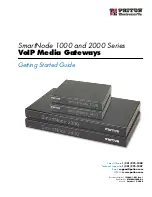
Appendix D Wireless LANs
ZyWALL USG 50-H User’s Guide
654
For EAP-TLS authentication type, you must first have a wired connection to the network and
obtain the certificate(s) from a certificate authority (CA). A certificate (also called digital IDs)
can be used to authenticate users and a CA issues certificates and guarantees the identity of
each certificate owner.
EAP-MD5 (Message-Digest Algorithm 5)
MD5 authentication is the simplest one-way authentication method. The authentication server
sends a challenge to the wireless client. The wireless client ‘proves’ that it knows the password
by encrypting the password with the challenge and sends back the information. Password is
not sent in plain text.
However, MD5 authentication has some weaknesses. Since the authentication server needs to
get the plaintext passwords, the passwords must be stored. Thus someone other than the
authentication server may access the password file. In addition, it is possible to impersonate an
authentication server as MD5 authentication method does not perform mutual authentication.
Finally, MD5 authentication method does not support data encryption with dynamic session
key. You must configure WEP encryption keys for data encryption.
EAP-TLS (Transport Layer Security)
With EAP-TLS, digital certifications are needed by both the server and the wireless clients for
mutual authentication. The server presents a certificate to the client. After validating the
identity of the server, the client sends a different certificate to the server. The exchange of
certificates is done in the open before a secured tunnel is created. This makes user identity
vulnerable to passive attacks. A digital certificate is an electronic ID card that authenticates the
sender’s identity. However, to implement EAP-TLS, you need a Certificate Authority (CA) to
handle certificates, which imposes a management overhead.
EAP-TTLS (Tunneled Transport Layer Service)
EAP-TTLS is an extension of the EAP-TLS authentication that uses certificates for only the
server-side authentications to establish a secure connection. Client authentication is then done
by sending username and password through the secure connection, thus client identity is
protected. For client authentication, EAP-TTLS supports EAP methods and legacy
authentication methods such as PAP, CHAP, MS-CHAP and MS-CHAP v2.
PEAP (Protected EAP)
Like EAP-TTLS, server-side certificate authentication is used to establish a secure connection,
then use simple username and password methods through the secured connection to
authenticate the clients, thus hiding client identity. However, PEAP only supports EAP
methods, such as EAP-MD5, EAP-MSCHAPv2 and EAP-GTC (EAP-Generic Token Card),
for client authentication. EAP-GTC is implemented only by Cisco.
LEAP
LEAP (Lightweight Extensible Authentication Protocol) is a Cisco implementation of IEEE
802.1x.
Summary of Contents for ZyWall USG 50-H Series
Page 2: ......
Page 10: ...Safety Warnings ZyWALL USG 50 H User s Guide 10...
Page 28: ...Table of Contents ZyWALL USG 50 H User s Guide 28...
Page 30: ...30...
Page 34: ...Chapter 1 Introducing the ZyWALL ZyWALL USG 50 H User s Guide 34...
Page 40: ...Chapter 2 Features and Applications ZyWALL USG 50 H User s Guide 40...
Page 92: ...Chapter 5 Configuration Basics ZyWALL USG 50 H User s Guide 92...
Page 130: ...Chapter 6 Tutorials ZyWALL USG 50 H User s Guide 130...
Page 146: ...146...
Page 208: ...Chapter 8 Interface ZyWALL USG 50 H User s Guide 208 Figure 161 Network Interface Bridge Add...
Page 224: ...Chapter 9 Trunks ZyWALL USG 50 H User s Guide 224...
Page 250: ...Chapter 12 Zones ZyWALL USG 50 H User s Guide 250...
Page 280: ...Chapter 16 ALG ZyWALL USG 50 H User s Guide 280...
Page 286: ...Chapter 17 IP MAC Binding ZyWALL USG 50 H User s Guide 286...
Page 287: ...287 PART III Firewall Firewall 289...
Page 288: ...288...
Page 304: ...Chapter 18 Firewall ZyWALL USG 50 H User s Guide 304...
Page 306: ...306...
Page 356: ...Chapter 21 SSL User Screens ZyWALL USG 50 H User s Guide 356...
Page 358: ...Chapter 22 SSL User Application Screens ZyWALL USG 50 H User s Guide 358...
Page 368: ...Chapter 24 L2TP VPN ZyWALL USG 50 H User s Guide 368...
Page 394: ...Chapter 25 L2TP VPN Example ZyWALL USG 50 H User s Guide 394...
Page 395: ...395 PART V Application Patrol Application Patrol BWM 397...
Page 396: ...396...
Page 421: ...421 PART VI Anti X ADP 423...
Page 422: ...422...
Page 429: ...Chapter 27 ADP ZyWALL USG 50 H User s Guide 429 Figure 359 Profiles Traffic Anomaly...
Page 432: ...Chapter 27 ADP ZyWALL USG 50 H User s Guide 432 Figure 360 Profiles Protocol Anomaly...
Page 440: ...Chapter 27 ADP ZyWALL USG 50 H User s Guide 440...
Page 442: ...442...
Page 462: ...Chapter 29 Addresses ZyWALL USG 50 H User s Guide 462...
Page 474: ...Chapter 31 Schedules ZyWALL USG 50 H User s Guide 474...
Page 484: ...Chapter 32 AAA Server ZyWALL USG 50 H User s Guide 484...
Page 506: ...Chapter 34 Certificates ZyWALL USG 50 H User s Guide 506...
Page 510: ...Chapter 35 SSL Application ZyWALL USG 50 H User s Guide 510...
Page 511: ...511 PART VIII System System 513...
Page 512: ...512...
Page 552: ...552...
Page 584: ...Chapter 40 Diagnostics ZyWALL USG 50 H User s Guide 584...
Page 586: ...Chapter 41 Reboot ZyWALL USG 50 H User s Guide 586...
Page 596: ...Chapter 43 Product Specifications ZyWALL USG 50 H User s Guide 596...
Page 598: ...598...
Page 636: ...Appendix A Log Descriptions ZyWALL USG 50 H User s Guide 636...
Page 640: ...Appendix B Common Services ZyWALL USG 50 H User s Guide 640...
Page 646: ...Appendix C Importing Certificates ZyWALL USG 50 H User s Guide 646...















































